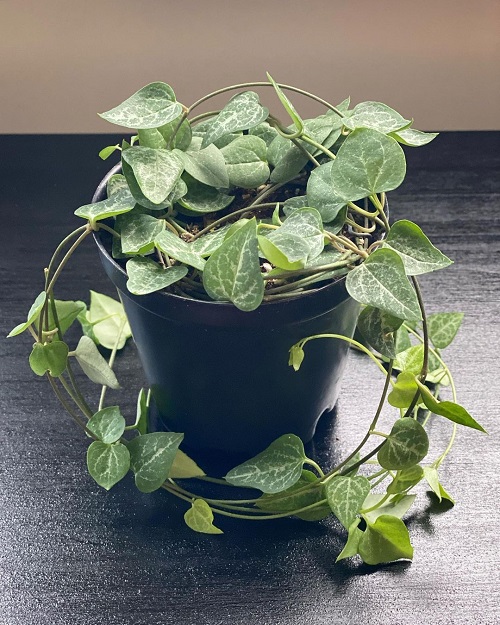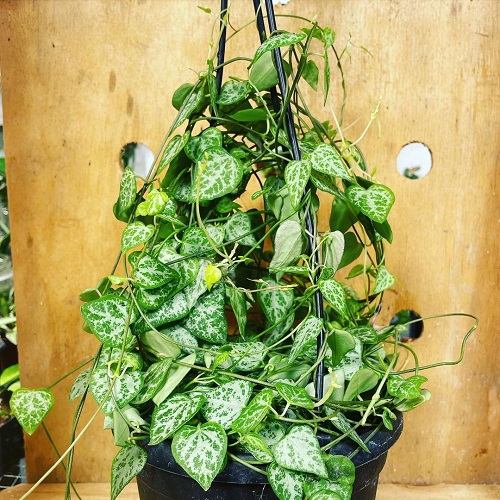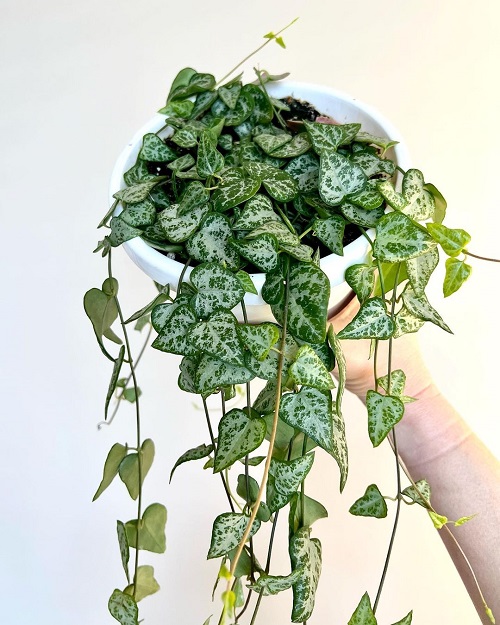With its distinctive arrow-shaped leaves and low demands, String of Arrows is ought to be a conversation starter in any room!

Native to South Africa, String of Arrows is distinguished by its arrow-shaped leaves, excellent vining pattern, and low demands, making it an absolute delight to grow! If you’re interested in Growing String of Arrows Indoors, here’s all the information you need to get started!
- Botanical Name: Ceropegia woodii “String of Arrows”
- Popular as—Chain of Hearts, String of Hearts, Rosary Vine, Hearts-on-a-String
- Vines grow up to 2-3 feet long
- Thrives well in bright and indirect sunlight
- Non-toxic to pets
Learn about Growing an Indoor Variegated String of Pearls here
String of Arrows Plant Profile
A vining succulent with exceptional visual appearance, String of Arrows is a member of the Asteraceae family. True to its name, the leaves resemble tiny green arrows with prominent gray venation. Each leaf measures around 2-3 cm in length, and the vines can grow up to 3-4 feet long, making it a perfect choice for decorating small spaces.
The leaves are densely packed along the stem, creating a cascading effect that resembles a flowing river of greenery. If you wish to enjoy the many shades of your Rosary Vines, experiment with the lighting conditions, and you’ll find the succulent leaves tinted with shades of blue and rosy red.
Ideal Pot Size
Pick a container that is one size bigger than the plant’s root ball to avoid pooling of excess water at the bottom, besides providing the roots enough space to breathe. Ideally, a 4-6 inches pot with enough drainage holes is good enough for a young String of Arrows.
You may repot it to a bigger pot when you see the roots peeping out of the drainage holes. Ensure enough holes at the bottom of the container to aid drainage.
Propagating String of Arrows Indoors

Propagating a String of Arrows is relatively easy and can be done in a few simple steps:
- Locate a robust vine from a healthy String of Arrows plant.
- Cut a 4-6 inches long section with 3–4 leaves just below the leaf node, using a sterilized pair of scissors.
- Allow a day or two for the vine’s cut end to callus over. This will prevent it from rotting when buried in the medium.
- Fill a pot with a well-draining medium and carefully press the vine’s cut end into it, making sure to bury at least one node.
- Lightly water the newly planted vine, then place it in an area with indirect, bright light. Avoid direct sunlight since it might dry up the soil and burn the foliage.
- Make sure the soil is continuously moist but not soggy.
It will take 2-3 weeks for the cutting to root and begin to grow. Be patient and avoid disturbing the cutting during this time.
Requirements of String of Arrows Indoors

Light
For a breathtaking display of the String of Arrows, provide the plant with ample direct sunlight. Opt for a south-facing window that receives abundant bright afternoon light, and watch the heart-shaped leaves develop a striking exotic red hue. On the other hand, insufficient sunlight can result in the leaves fading to a dull green, so make sure to avoid such situations. However, if you find the leaves getting scorched, move the plant indoors or drape a light-filtering curtain.
During the winter months, when natural light is scarce, supplement the String of Arrows with artificial lightings, such as a grow light, to keep it thriving.
Soil
Use a cactus or succulent soil mix to provide good drainage and aeration for String of Arrows. Mix in equal parts of perlite or sand with regular potting soil to create a well-draining potting mix. Avoid heavy or clayey mediums as they retain too much water and cause root rot.
Alternatively, you may also use an orchid mix mixed with a fistful of perlite.
Water
To ensure the healthy growth of your String of Arrows, it is crucial to keep the soil dry, as this plant is susceptible to root rot if overwatered. Before giving it another watering, wait until the soil is completely dry. A quick way to check for moisture content is to stick your finger in the soil. If the soil feels dry, then it is time to water the plant.
Adjust the frequency of watering based on the season and keep an eye on the top layer of the medium.
Temperature & Humidity
The String of Arrows plant prefers warm temperatures between 65 to 75 F or 18-23 C. Avoid exposing the plant to temperatures below 50°F (10°C), as this can cause stunt its growth or make it leggier.
While the Rosary Vines prefer dry soil, it benefits from a slightly humid environment. Keep the humidity levels around the plant between 30 and 50%. You can increase humidity by placing a humidifier near the plant, grouping plants together to create a humid microclimate, or placing a tray of water near the plant.
String of Arrows Care

Fertilizer
A suitable option for fertilizing your plants is to use a balanced NPK feed every 4-6 weeks during the spring and summer. Ensure to dilute the fertilizer to half the recommended strength to avoid burning the roots. Over-fertilizing can damage the plant, so it’s best to be cautious.
Since the String of Arrows plant goes through dormancy in the winter, it requires less fertilizer during this time. So refrain from fertilizing the plant during the colder months.
Pest & Diseases
The String of Arrows is generally a low-maintenance and pest-resistant plant. However, it can still be susceptible to pests in indoor growing conditions. Mealybugs, spider mites, and scale insects are some common pests that can infest this beauty. You can use any of the following cure methods, depending on the type of pest infestation:
- Wipe the leaves and stems of the plant with a cotton ball dipped in rubbing alcohol.
- Spray the plant with a solution of water and dish soap.
- Use dish soap, commercial insecticidal soap, neem oil, or horticultural oil spray on a monthly basis.
- Keep wiping the leaves with a clean cloth to remove the eggs of pests, if any.






